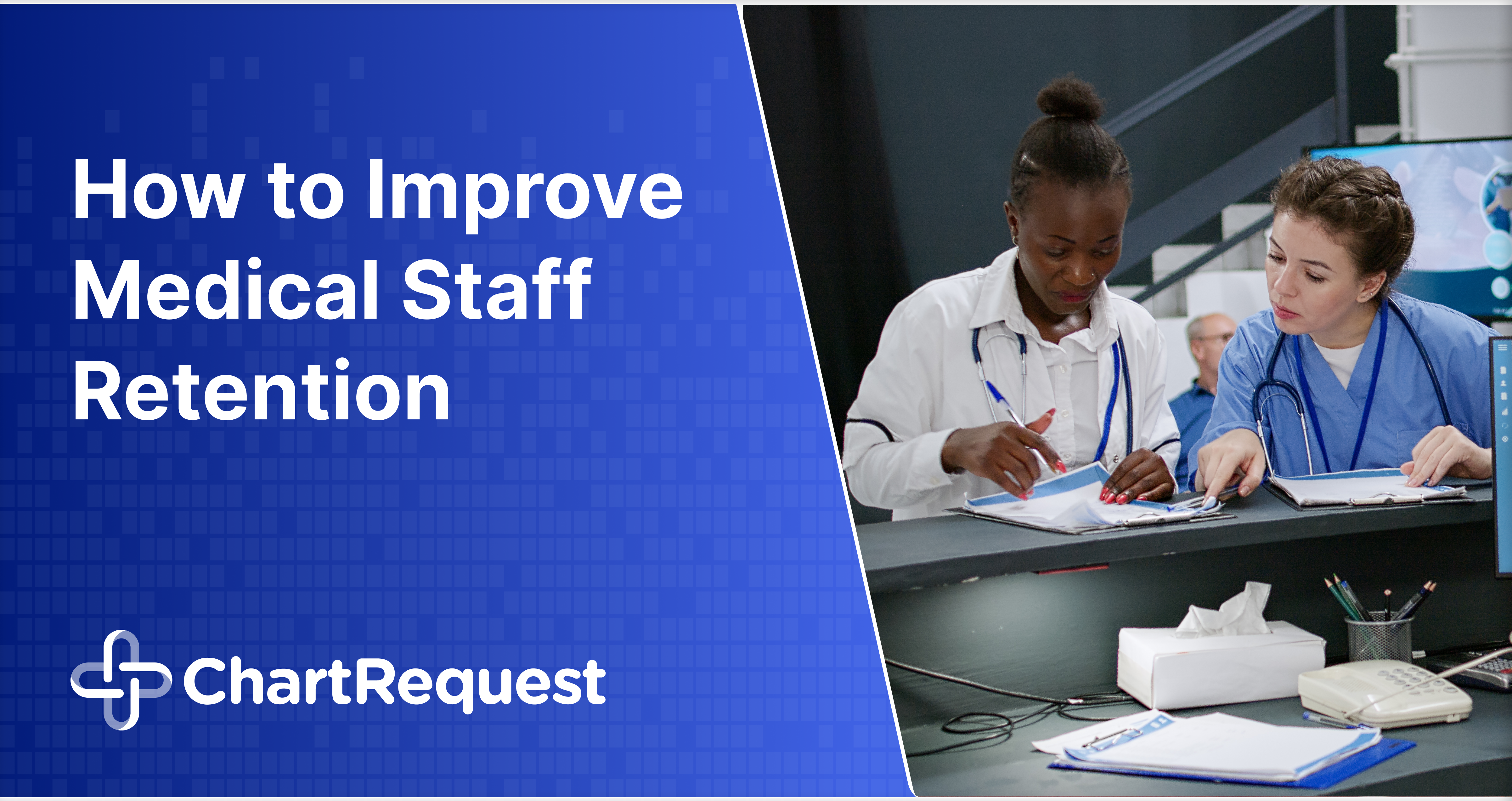The COVID-19 pandemic pushed medical staffing to its limits with brutal hours and demanding workplace conditions. Many hospitals experienced a nurse and physician shortage, even after the government ended the national emergency in 2023.
Employee burnout, increasing patient demands, and high expectations of doctors create a turnover risk for both small and enterprise-level practices. In fact, healthcare has the second-highest rate of employee turnover of any professional industry.
So, what can your practice do to retain its employees? We’ll answer this question below.
Augment your staff with ChartRequest.
Proper Training for Success
Treating patients requires adequate resources and available hands. Hiring staff for a variety of complex roles will become necessary as your practice grows.
The Health Insurance Portability and Accountability Act (HIPAA) sets guidelines for medical training. Put briefly, HIPAA requires admins to train their staff “as necessary and appropriate” to maintain proper compliance with healthcare regulations. While this rule doesn’t indicate how long training should last, it applies to any individual who can access or view protected health information.
Many practices retrain their staff on critical systems for 1-2 hours every year. However, new staff may expect training to last weeks and include both in-person and online courses. It’s a good idea to outline your training procedure in your onboarding policy to ensure consistent and effective results.
Here are a few training strategies that can improve medical staff retention:
- Demonstrate the use of applicable and relevant technologies
- Create mock incidents for new employees to resolve
- Oversee workplace policy meetings and include new employees
- Ask new employees for feedback about their training
Failure to provide adequate training will put your healthcare facility at compliance risk. HIPAA penalties could include up to $1.5 million per violation category a year. Including onboarding, training, and other administrative costs, replacing healthcare employees can easily cost your business $10,000 or more.
Why Do Doctors Quit?
Morning Consult found that 18% of new healthcare employees quit their jobs during the first half of the 2020s. 78% of healthcare providers experienced immediate labor shortages as a result.
Trends from across the industry indicate these are the common reasons doctors, nurses, and desk staff quit:
- Stress and Burnout: Many healthcare workers feel overwhelmed by their responsibilities and high-stress roles.
- Non-Competitive Pay: Many hospitals fail to maintain a competitive salary for employees, causing workers to question their commitment after their first year.
- Lack of Support: Employees who don’t have the resources or leadership they need to succeed tend to look elsewhere for work.
- Work-Life Balance: Some workers spend most of their day managing overtime and increasing hospital demands.
- Administrative Burdens: Employees spend too much time managing electronic health records and reporting while falling behind on other tasks.
The irony is that many healthcare employees also quit due to understaffing or high turnover. Coworker chemistry may be non-existent in some practices, and a loss of staff can worsen morale.
Remember that your facility’s needs will not stop when someone walks away. It’s important to identify problems that cause staff turnaround before a work backlog becomes unmanageable.
How Can You Incentivize Medical Staff Retention?
Like all industries, offering competitive pay may be the quickest and most effective way to retain your staff. In 2020 alone, the average salary for nurses increased by about $10,000 — including larger sign-on bonuses. Workers were more willing to stick through stressful work conditions, knowing their compensation matched the workload.
Creating room in your budget for better salaries is one thing. Improving working conditions in your facility may require extra effort. 28% of polled healthcare workers say that a lack of respect and appreciation led to their quitting.
Highlighting inspiring members of the team, offering rewards for extra effort, and monitoring employee behavior can contribute to higher medical staff retention. This method could also improve your business reputation for both prospective employees and patients.
Providing personal development opportunities at work keeps your staff engaged and helps develop their key skills. Fostering an enriching environment and promoting from within can also improve workforce loyalty and community.
Lastly, it’s a good idea to implement technology solutions to reduce administrative burdens. Record management software and communication tools are great solutions to augment limited staff. These tools can minimize burnout and enable staff to spend more time with patients.
ChartRequest Reduces Burnout and Minimizes Administrative Work
Maintaining an adequate workforce in your healthcare practice can be like walking a tightrope. Fortunately, ChartRequest is ready to help streamline or automate record exchange by eliminating operational bottlenecks that cause burnout and retrieval delays.
We can integrate this solution into your existing EHR to save time and reduce release of information costs. Additionally, our augmented services can reduce the amount of staff time needed to complete these essential tasks — freeing your team from tedious workloads.
Schedule a consultation with ChartRequest to see how we can improve your medical staff retention rate.


